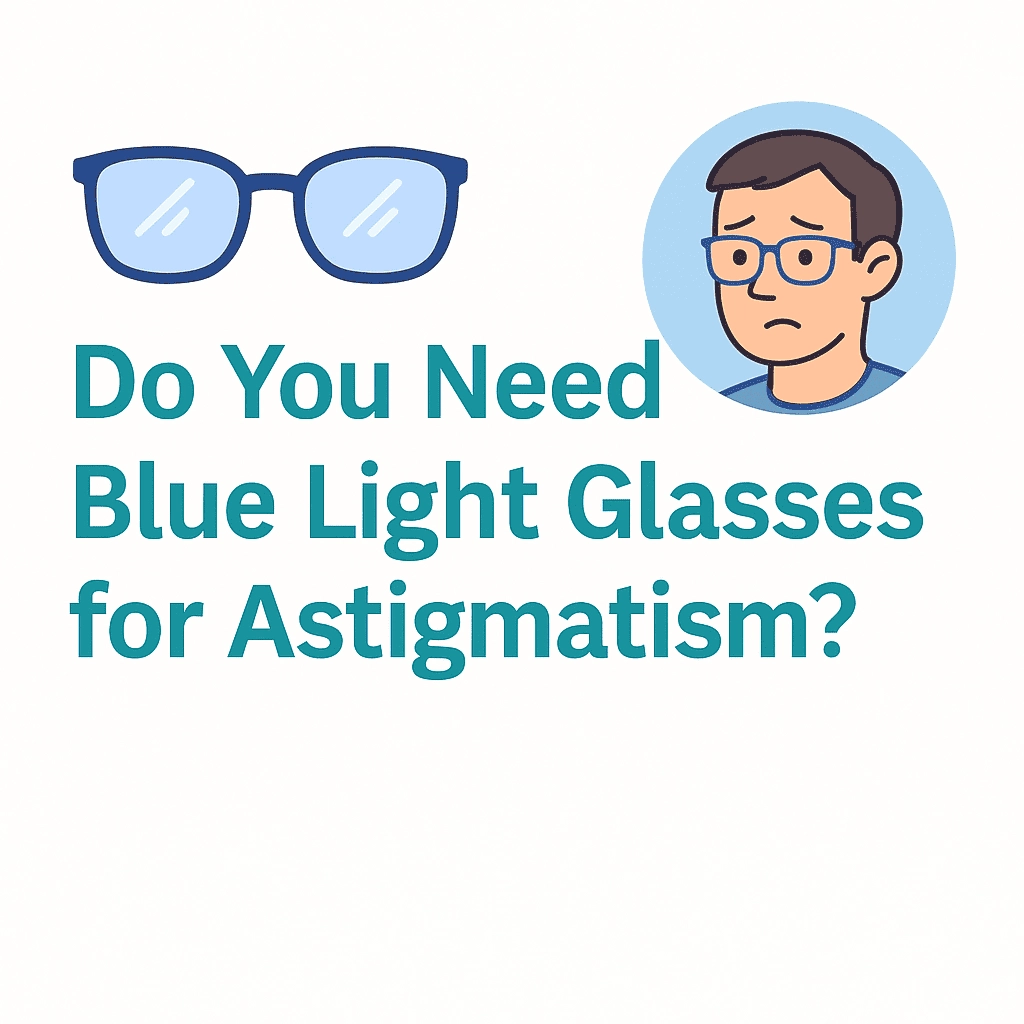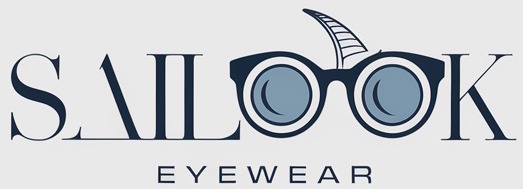As we spend more and more time in front of digital screens, the strain on our eyes becomes a significant concern. Among the various solutions people are exploring to alleviate this issue, blue light glasses have gained popularity. But what about astigmatism? Can blue light glasses help with this eye condition? In this article, we’ll explore the connection between blue light glasses and astigmatism, offering a comprehensive guide on what you need to know.

1.What Are Blue Light Glasses and How Do They Work?
Blue light glasses are specialized eyewear designed to block or filter out the blue light emitted from digital screens, LED lights, and other sources of artificial light. But here’s the kicker—blue light is everywhere. From your phone to your computer to the lights in your office, blue light is a common presence in modern life. Overexposure to blue light can lead to eye strain, sleep disruption, and even long-term vision problems.
So, how do these glasses work? They typically feature lenses that are coated with a special filter that absorbs or reflects blue light before it reaches the eyes. This is where it gets interesting—by blocking this harmful light, blue light glasses help reduce digital eye strain and improve comfort for people who spend long hours in front of screens.
Benefits of Blue Light Glasses
- Reduced eye strain: By blocking blue light, these glasses can help reduce fatigue associated with long screen usage.
- Improved sleep: Exposure to blue light, especially before bedtime, can disrupt sleep patterns. Blue light glasses can minimize this disruption, allowing for better sleep.
- Increased comfort: For individuals sensitive to blue light, wearing blue light glasses can provide noticeable comfort throughout the day.
Table 1: Key Benefits of Blue Light Glasses
| Benefit | Explanation |
|---|---|
| Reduced eye strain | Minimizes discomfort from prolonged screen time. |
| Improved sleep | Helps prevent blue light from interfering with sleep patterns. |
| Increased comfort | Enhances overall comfort for users sensitive to digital screens. |
2.What Is Astigmatism and How Does It Affect Vision?
Astigmatism is a common refractive error that occurs when the cornea or lens of the eye has an irregular shape, causing blurred or distorted vision. What’s the real story—when light enters the eye, it does not focus evenly on the retina, leading to difficulty in seeing clearly at all distances.
Symptoms of astigmatism can vary from mild to severe and often include:
- Blurred or distorted vision
- Eye strain or discomfort
- Frequent headaches
- Difficulty seeing at night
Astigmatism can occur in combination with other refractive errors like myopia (nearsightedness) or hyperopia (farsightedness). The condition is usually diagnosed through a comprehensive eye exam that involves measuring the curvature of the cornea and evaluating how the eyes focus light.
Table 2: Common Symptoms of Astigmatism
| Symptom | Description |
|---|---|
| Blurred or distorted vision | Vision is unclear at both near and far distances. |
| Eye strain or discomfort | Difficulty focusing, causing the eyes to feel tired or sore. |
| Frequent headaches | Often a result of eye strain or prolonged visual effort. |
| Difficulty seeing at night | Reduced vision clarity in low-light conditions. |
3.How Do Blue Light Glasses Affect Astigmatism?
While blue light glasses are effective for reducing eye strain and improving comfort, they don’t offer a solution for astigmatism. But here’s the kicker—while blue light glasses can help alleviate some of the symptoms associated with eye strain, they cannot correct the underlying refractive errors caused by astigmatism.
Astigmatism is a structural issue in the eye, not a result of digital strain or blue light exposure. To correct astigmatism, prescription lenses with the appropriate curvature are required. This is where it gets interesting—while blue light glasses won’t fix the root cause of astigmatism, they can still reduce the discomfort that comes with prolonged screen time, which can be especially beneficial for those with astigmatism who already experience eye strain.
Table 3: Blue Light Glasses vs. Astigmatism Treatment
| Treatment | Purpose |
|---|---|
| Blue light glasses | Reduce digital eye strain and improve comfort but do not correct astigmatism. |
| Prescription glasses | Correct astigmatism by adjusting the curvature of the eye for clearer vision. |
4.Can Blue Light Glasses Correct Astigmatism?
Blue light glasses are not a treatment for astigmatism. What’s the real story—astigmatism requires prescription lenses that are specifically designed to address the irregular shape of the cornea or lens. Blue light glasses, while effective at reducing strain caused by screens, do not alter the way the eye focuses light.
If you are experiencing blurred vision due to astigmatism, the best course of action is to consult with an eye care professional to get a prescription for corrective lenses. These lenses will have a specific curvature that corrects for the refractive error, allowing you to see clearly.
Table 4: Key Differences Between Blue Light Glasses and Prescription Glasses
| Feature | Blue Light Glasses | Prescription Glasses |
|---|---|---|
| Primary Purpose | Reduces eye strain from digital screens. | Corrects refractive errors like astigmatism. |
| Prescription Required | No | Yes |
| Effectiveness for Astigmatism | Does not correct astigmatism. | Corrects astigmatism with specific lenses. |
5.How Do Blue Light Glasses Help with Digital Eye Strain?
Digital eye strain is a growing concern in the modern age, particularly as people spend more time in front of screens. Ready for the good part—blue light glasses can significantly reduce digital eye strain by blocking or filtering out the harmful blue light that contributes to this condition.
Blue light is emitted by devices such as smartphones, laptops, and LED lighting, and overexposure to it can cause symptoms like dryness, discomfort, and blurred vision. Blue light glasses help by reducing the intensity of this light, leading to less strain and more comfort for users.
Table 5: Symptoms of Digital Eye Strain
| Symptom | Description |
|---|---|
| Dry or irritated eyes | Eyes may feel dry, itchy, or uncomfortable. |
| Blurred vision | Difficulty focusing on screens, leading to unclear vision. |
| Headaches | Often caused by prolonged exposure to blue light and screen time. |
6.What Are the Best Blue Light Glasses for People with Astigmatism?
While blue light glasses can’t correct astigmatism, they can provide comfort for those who experience eye strain as a result of long screen time. This is where it gets interesting—blue light glasses specifically designed for astigmatism are available, offering features that combine blue light filtering with corrective lenses.
For those with astigmatism, the best blue light glasses will have prescription lenses that correct the refractive error, while still filtering out harmful blue light. Several eyewear brands offer this combination, allowing for both comfort and clear vision.
Table 6: Best Features for Blue Light Glasses for Astigmatism
| Feature | Description |
|---|---|
| Prescription lenses | Corrects astigmatism while providing comfort. |
| Blue light filtering | Reduces eye strain from digital screens. |
| Lightweight frame | Ensures comfort during long hours of screen use. |
7. Are Blue Light Glasses Effective for Everyone?
Blue light glasses are not a one-size-fits-all solution. But here’s the kicker—while these glasses can significantly reduce discomfort for many people, their effectiveness may vary depending on individual needs. People who spend a lot of time in front of screens or who experience eye strain may find relief, while others may not notice as much of a difference. What’s the real story—not everyone needs blue light glasses, but for those who do, they can offer significant comfort, especially for users experiencing digital eye strain or fatigue from prolonged screen time.
That said, blue light glasses are more effective when used in conjunction with other eye health practices, such as taking regular breaks from screens, adjusting screen brightness, and maintaining proper lighting in your workspace. So, while they may not be a cure-all for everyone, blue light glasses can still be an essential tool for many.
Table 7: Effectiveness of Blue Light Glasses
| Type of User | Effectiveness of Blue Light Glasses | Reason |
|---|---|---|
| Frequent Screen Users | High | Reduces eye strain and discomfort during prolonged screen use. |
| Occasional Screen Users | Moderate | May not notice significant improvement. |
| Individuals with Eye Sensitivity | Very High | Greatly reduces discomfort and irritation. |
| Individuals without Eye Strain | Low | May not notice a substantial difference. |
8. Should You Wear Blue Light Glasses if You Have Astigmatism?
If you have astigmatism, blue light glasses can help reduce discomfort caused by digital eye strain but won’t correct the condition itself. This is where it gets interesting—using blue light glasses as a complement to prescription lenses can improve your overall comfort. If you already wear corrective lenses for astigmatism, wearing blue light glasses on top may provide added relief.
Astigmatism is caused by the irregular shape of the cornea, and it requires corrective lenses to ensure clear vision. However, blue light glasses can be worn in addition to prescription eyewear to alleviate the discomfort caused by digital screens and artificial lighting. Always consult with your eye care provider to determine the best solution for your needs.
Table 8: Blue Light Glasses for People with Astigmatism
| Solution | Benefit | Considerations |
|---|---|---|
| Blue Light Glasses Only | Helps reduce digital eye strain | Does not correct astigmatism |
| Prescription Glasses for Astigmatism + Blue Light Glasses | Corrects astigmatism while reducing strain from screens | Best for those already wearing corrective lenses |
9. How to Choose the Right Blue Light Glasses for Your Needs?
When selecting blue light glasses, several factors should be considered to ensure you get the most benefit. What’s the real story—the right pair of blue light glasses for you will depend on factors like frame style, comfort, and lens features. Choosing glasses with the right fit is crucial. If you have astigmatism, you should also ensure that your glasses can be customized with prescription lenses for the best comfort and vision.
Look for glasses with a comfortable fit and durable frame material. Lenses should effectively filter blue light without distorting your vision. For those with astigmatism, make sure to choose glasses that also offer prescription options. The right pair of blue light glasses should reduce strain without sacrificing your comfort or visual clarity.
Table 9: Factors to Consider When Choosing Blue Light Glasses
| Factor | Description |
|---|---|
| Frame Style | Choose a frame that fits comfortably and suits your face shape. |
| Lens Features | Ensure the lenses filter blue light effectively without causing distortion. |
| Prescription Options | For astigmatism, look for blue light glasses with prescription lens compatibility. |
10. How Can You Tell If Blue Light Glasses Are Working for You?
It can take some time to notice the benefits of blue light glasses, especially if you’ve been experiencing eye strain for a long period. Ready for the good part—if your eyes feel less fatigued, your vision is clearer, and your overall comfort improves, you can be confident that your blue light glasses are working.
If you experience a reduction in headaches, less dryness, and fewer instances of eye strain after using the glasses, it’s a clear indication they are effective. Remember, consistent usage is key to maximizing the benefits.
Table 10: Signs That Blue Light Glasses Are Working
| Sign of Effectiveness | What It Means |
|---|---|
| Reduced eye fatigue | The glasses are helping reduce digital eye strain. |
| Clearer vision | The glasses are not distorting your vision, while also protecting from blue light. |
| Fewer headaches and dryness | The glasses are alleviating common symptoms of digital eye strain. |
11. What Are the Alternatives to Blue Light Glasses for Astigmatism?
If you’re not sold on blue light glasses, there are alternatives to consider. But here’s the kicker—prescription glasses that correct astigmatism can provide clearer vision, while also offering protection from digital eye strain. Additionally, screen filters can be added to your devices to block blue light.
Other options include making changes to your work environment, such as improving lighting or taking regular breaks to reduce eye strain. This is where it gets interesting—while blue light glasses are a great solution, alternatives can also be just as effective for reducing digital eye strain and improving overall eye health.
Table 11: Alternatives to Blue Light Glasses
| Alternative Solution | Benefit |
|---|---|
| Prescription Glasses for Astigmatism | Corrects astigmatism and may include blue light protection. |
| Screen Filters | Blocks blue light from digital devices without needing glasses. |
| Improved Lighting and Breaks | Reduces eye strain by minimizing screen time exposure and improving work conditions. |
12. Can Blue Light Glasses Be Worn During the Day?
While blue light glasses are often marketed as solutions for digital screens, they can be worn throughout the day. What’s the real story—they can help reduce glare from artificial lights and prevent eye strain from prolonged exposure to blue light, even during daylight hours. This can be especially helpful in environments with a lot of fluorescent or LED lighting.
In fact, wearing blue light glasses during the day can also protect your eyes from the harmful effects of excessive exposure to blue light, regardless of whether you’re in front of a screen.
Table 12: Benefits of Wearing Blue Light Glasses During the Day
| Time of Use | Benefit |
|---|---|
| During Screen Time | Reduces eye strain and protects against blue light. |
| In Bright Office Lighting | Prevents glare from artificial lighting, reducing strain. |
| Outdoors or in Natural Light | Helps protect the eyes from ambient blue light exposure. |
13. Are Blue Light Glasses a Long-Term Solution for Eye Health?
Blue light glasses can provide relief for digital eye strain, but they are not a long-term solution to eye health problems. But here’s the kicker—while they help with immediate comfort, it’s essential to combine them with other habits that promote eye health, such as taking breaks, adjusting your screen settings, and visiting your eye care provider regularly.
What’s the real story—while blue light glasses can help in the short term, they should be part of a larger strategy for maintaining healthy eyes. For long-term health, make sure to practice good screen habits and visit an eye care professional regularly.
Table 13: Long-Term Eye Health Habits
| Habit | Benefit |
|---|---|
| Regular Breaks from Screens | Reduces continuous strain and allows eyes to rest. |
| Proper Lighting in Workspace | Reduces glare and strain caused by poor lighting. |
| Regular Eye Exams | Ensures early detection and correction of eye conditions like astigmatism. |
14. What Does the Research Say About Blue Light Glasses for Astigmatism?
Research into blue light glasses and their effectiveness for astigmatism is still ongoing. What’s the real story—while there is no evidence to suggest that blue light glasses can correct astigmatism, they have been shown to reduce eye strain and improve comfort, especially for those who spend extended periods of time on digital devices.
The latest studies confirm that while blue light glasses won’t treat astigmatism directly, they offer significant benefits for users experiencing digital eye strain, which can be especially useful for individuals with astigmatism who already experience discomfort from screen time.
Table 14: Key Findings from Research on Blue Light Glasses
| Study Finding | Implication |
|---|---|
| Blue light glasses reduce eye strain | Provides comfort, especially for people with astigmatism. |
| No evidence of correction for astigmatism | Blue light glasses do not treat the underlying refractive error. |
| Long-term usage improves comfort | Consistent use helps alleviate discomfort from prolonged screen exposure. |
15. Conclusion
To wrap things up, blue light glasses can provide significant relief for those suffering from digital eye strain, but they are not a solution for astigmatism. If you have astigmatism, prescription glasses are necessary for correcting the refractive error. However, using blue light glasses alongside your regular eyewear can improve overall comfort and reduce strain. Always consult with an eye care professional for the best advice tailored to your needs.
FAQ Section
Q1: What are blue light glasses?
Blue light glasses are eyewear designed to filter out blue light, helping to reduce eye strain from digital screens and artificial lighting.
Q2: How do blue light glasses work?
Blue light glasses work by blocking or reflecting blue light, which reduces the strain on your eyes during prolonged screen time.
Q3: Can blue light glasses help with astigmatism?
No, blue light glasses do not correct astigmatism. They can reduce eye strain but cannot fix refractive errors like astigmatism.
Q4: Are blue light glasses effective for everyone?
Blue light glasses are most effective for those who experience eye strain from long screen use, but their effectiveness may vary depending on individual needs.
Q5: Should I wear blue light glasses if I have astigmatism?
If you have astigmatism, blue light glasses can help reduce eye strain, but you will still need prescription glasses to correct your astigmatism.

